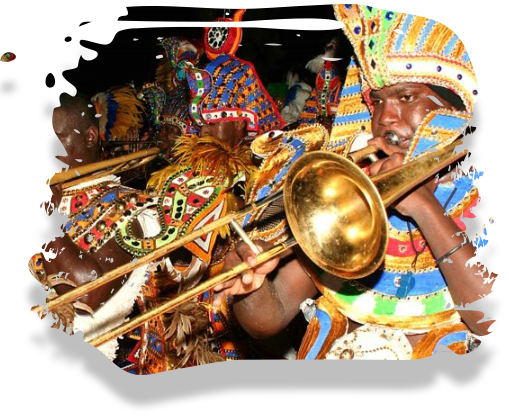
Cordell Thompson, local Exuma Historian and Director of the Pompey Center for Studies in Traditional Art, Music, Food and the Unresolved Mysteries, describes the origins and components of the Bahamian Junkanoo festival.
Q: What exactly is Junkanoo?
A: Junkanoo is the colorful, energetic, and breath-taking Bahamian festival that takes place every year on Boxing Day and New Year’s Day. Starting at 2:00 a.m. and coming to an end only when the sun rises (around 9:00 a.m.), hundreds of people dressed in bright, extravagant costumes parade through the streets playing authentic Bahamian instruments, performing choreographed dance routines, and celebrating their culture. The influence of Junkanoo is seen in all aspects of Bahamian society, in the fine arts, in music and dance, and particularly the personality and attitudes of the Bahamian people who understand the necessity for taking time out to celebrate life.
Q: When and how did it start?
A: Around the 16th or 17th century, Bahamian slaves were given several days off around Christmas time, during which they would celebrate by spending time with their families. In their three days of freedom, they would dance, play music, and create costumes as a way to enjoy the holiday. Even after slavery was abolished, this tradition continued in the Bahamas and eventually transformed into the spectacular festival it is today.
Q: Where does Junkanoo take place?
A: Junkanoo has its roots in harvest festivals in the African countries of Ghana and Nigeria. Most Africans who came to the Americas came from these two countries and Junkanoo is celebrated in some shape or form from the Southern United States to as far south as Belize in Central America. It is still celebrated in the town of New Berne in South Carolina, in the town of Leon in Puerto Rico, in Jamaica, but nowhere is it observed with as much vigor and vitality as in The Bahamas today. Although the largest parade takes place in the Bahamian capital of Nassau, Junaknoo is also preformed in the Exumas, The Abacos, Bimini, Harbour Island, and Grand Bahama Island.
Q: Who participates in Junkanoo?
A: In The Bahamas, Junkanoo has evolved to something closer to Carnival in Brazil, where groups of two thousand members or more, drawn from social clubs and close knit communities, take to the streets as organized “gangs”, to compete for the honor of simply being named and recognized as the best group on the island. The rivalry is friendly and gangs are judged on best music, best costumes, best dancing, with the accumulation of the most points in each category determining the winners. Groups spend almost half the year selecting, and executing their themes which are usually drawn from mythology, history or contemporary events, and which are executed with almost life like depiction from cardboard and fringed paper. Among the most famous Junkaroo groups include The Valley Boys, The Saxons, The Roots and One Family.
Q: What kinds of musical instruments are used in the festival?
A: During the procession, groups play traditional Bahamian instruments, such as cowbells, horns, scrapers, whistles, and drums made of sheep or goat skin. In addition, many participants use brass instruments (like trombones and flutes), which allow them to include famous pop songs and create a wider array of sounds in their music
Q: What about the costumes?
A: The exquisite costumes worn during the parade take groups anywhere from 6 months to a year to create. The design is carefully drawn out on cardboard before aluminum rods are used to fashion the frame. Afterwards, groups meticulously layer crepe paper over the cardboard and add finishing touches with beads, glitter, and feathers. The costumes reflect the group’s chosen theme and often include headdresses, can be up to 15 feet tall, and weigh over 100 pounds.
Found at ExpressionsByAnn
© 1998-2013 Kate Zhukova and Kenneth Bowe, Chat ‘N’ Chill® Ltd.
Want to use this article on your Blog, website or newsletter?
You can as long as you include this complete copyright and statement:
© 1998-2013 Kate Zhukova and Kenneth Bowe, Chat ‘N’ Chill® Ltd.
Kenneth Bowe, is creator and owner of Chat ‘N’ Chill®, an Exuma, Bahamas based destination wedding venue, event planning and design company serving The Central Bahamas.
Get your Complimentary e-Guide, “7 Biggest Pitfalls Destination Brides Make When Planning Their Wedding That Cost Them Thousands!” by visiting www.AWeddingBreeze.com!


